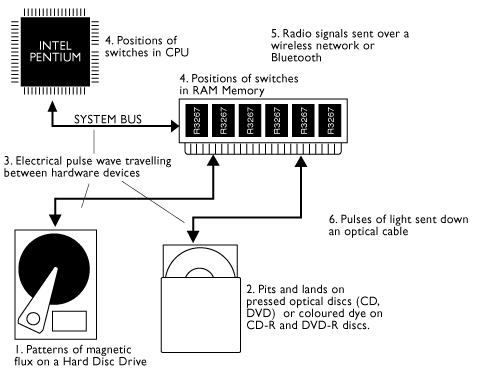In a computer system, binary data may exist in several different forms at different times ...
- Electrical pulse waves
- Positions of switches (RAM etc memory)
- Patterns of magnetic flux
- Pits and lands or differing coloured dyes on the surface of an optical disc (CD, DVD etc)
- Radio signals sent over a wireless network
- Pulses of light sent down an optical cable

1. Electrical pulse wave
When traveling between components such as ...
- a CD drive/disc and RAM memory
- a MIDI keyboard and MIDI interface
- a computer and a connected printer
- a modem and the internet
- a scanner and RAM memory
- etc
... a binary data stream takes the form of an electrical pulse wave. Pulse waves are used because they are ideal for representing the on/off states of binary bits.

2. Positions of switches (RAM & CPU etc)
When a binary electrical pulse wave has arrived at a RAM, FlashRAM or ROM memory module or the CPU, the waves on/off states are translated into on/off positions of millions of switches (transistors) which temporarily "hold" the binary values.

3. Patterns of magnetic flux (on floppy, removable& hard disks)
On the surface of a floppy disc or hard drive, 1s and 0s are recorded as a pattern of strong and weak magnetic pulses. More on hard disc drives is here.

4. Pits and lands / light sensitive surfaces (optical media)
Pressed / manufactured optical discs
A master disc is created from which copies are made. The master is created with a laser which turns on and off according to the data to be recorded. When the laser turns on (when a 1 is sent to it) it burns a so called "pit" into the surface of the master. When it is turned off (when a 0 is sent to it) no pit is created. This area is called a "land". A number of glass masters are made from the first master, and these are used to duplicate (press) the finished product.
When the disc is played, a reading laser shines light onto the surface of the disc. The light takes longer to reflect from a pit than a land. This difference in the wavelength of the reflected light is recognised by the laser and a transducer converts the difference into an electrical digital pulse wave.

CD-R/RW and DVD-R/RW
CD-R/RW and DVD-R/RW work differently by using a laser to change the colour of a light sensitive dye which is spread across the surface of the disc. A reading laser differentiates between the wavelengths of the dyes to recover the 1s and 0s.
5. Radio signals sent over a wireless network
Binary 1s and 0s can be transmitted over a wireless network in the form of radio waves.

6. Optical signals
Binary 1s and 0s can be transmitted down an optical cable in the form of pulses of light.
